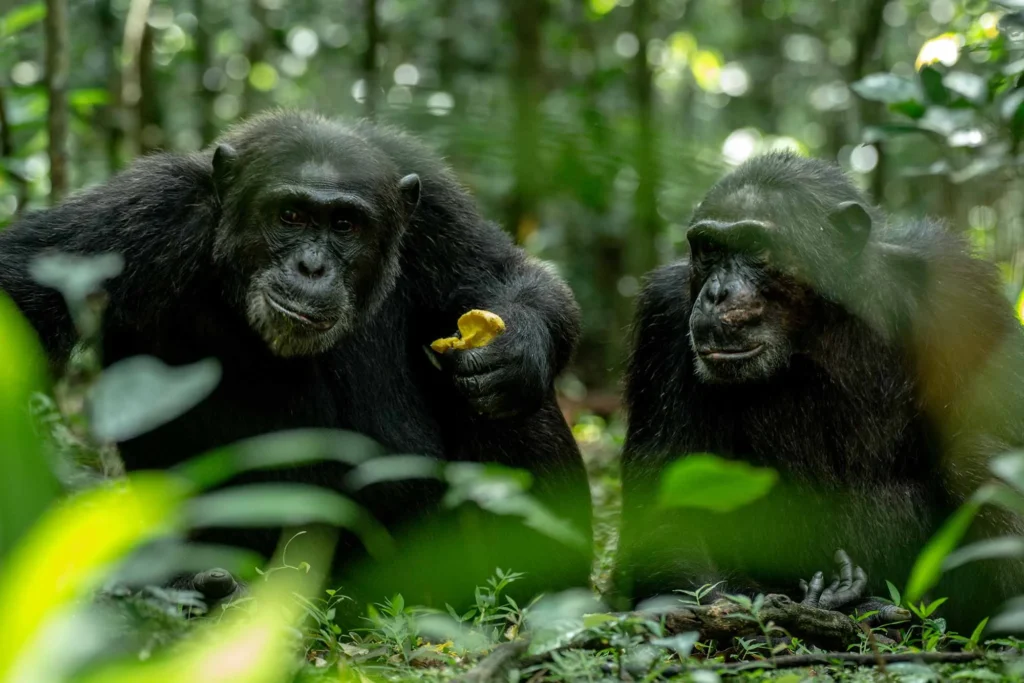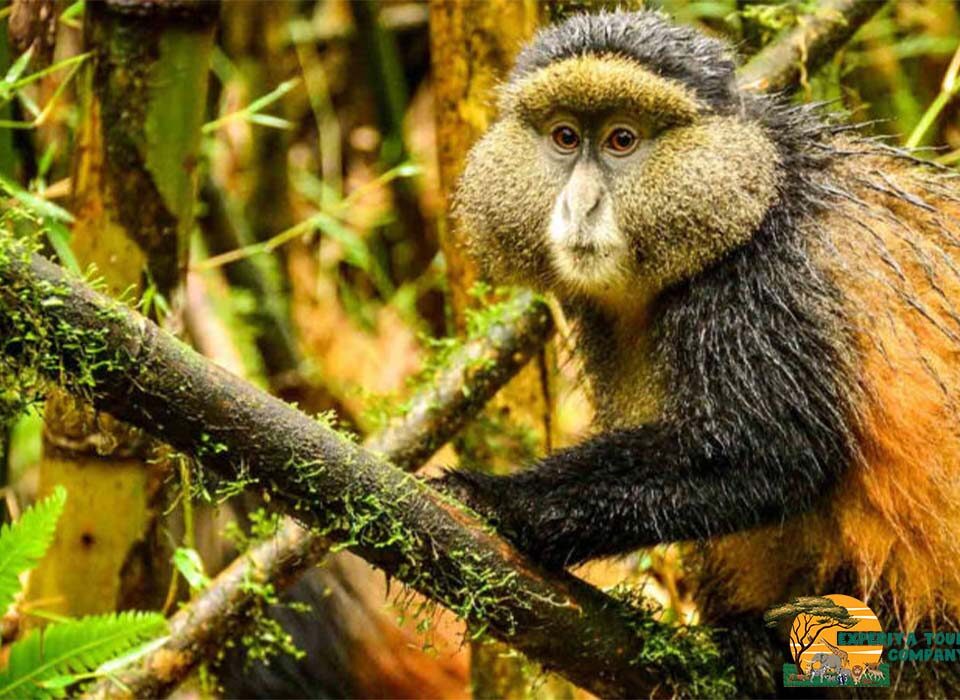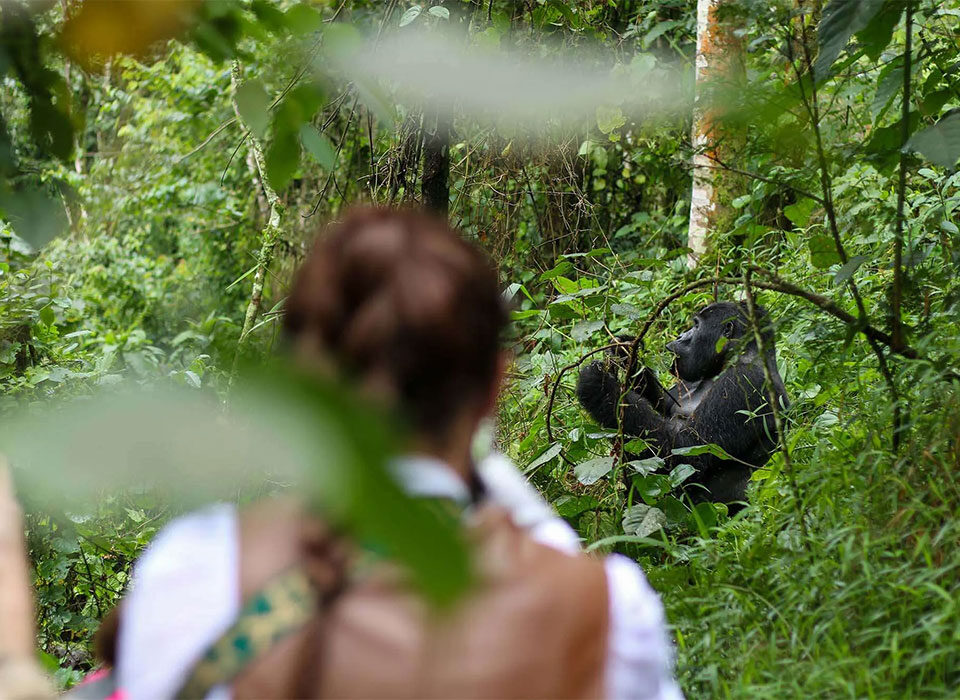
Can I Do a Full-Day Chimpanzee Habituation Experience? | Uganda Safari Guide
October 24, 2025
Are Chimpanzees Dangerous to Track? | Uganda Primate Safari Guide
October 24, 2025What’s the Best Time to Track Chimps in Uganda? | Uganda Safari Guide

What’s the Best Time to Track Chimps in Uganda?
Chimpanzee tracking in Uganda is one of the most exhilarating wildlife experiences Africa has to offer. Deep in the country’s lush forests, you can walk alongside expert guides, listening to distant pant-hoots and rustling branches before finally spotting a group of wild chimpanzees leaping through the treetops or grooming on the forest floor. These fascinating primates share nearly 98% of human DNA, making encounters with them not only thrilling but deeply emotional and thought-provoking.
But one of the most common questions travelers ask when planning this adventure is: “What’s the best time to track chimps in Uganda?”
While chimpanzee tracking can technically be done year-round, understanding Uganda’s seasons, weather patterns, and forest conditions can make a big difference in the quality of your experience. From easier trekking paths during dry months to better visibility for photography, timing your visit well can greatly enhance your safari.
In this article, we’ll explore the best times of year to track chimpanzees in Uganda, what to expect in each season, and how to make the most of your encounter — whether you visit Kibale, Budongo, Kalinzu, or Kyambura Gorge.
Understanding Uganda’s Climate and Seasons
Uganda’s climate is typically tropical, with warm temperatures throughout the year due to its location near the equator. However, rainfall patterns divide the year into dry seasons and wet seasons, which greatly influence chimpanzee tracking conditions.
The country’s two dry seasons occur from December to February and from June to September. These months are generally considered the best for wildlife safaris and primate trekking because trails are less muddy, the forest is more accessible, and the chances of heavy rain are low.
The wet seasons run from March to May and October to November, bringing lush green vegetation, blooming flowers, and abundant fruiting trees — a favorite for chimpanzees. However, these months can make trekking more challenging, as trails become slippery and rain showers can be unpredictable.
That said, Uganda’s rain rarely lasts the whole day; it often comes in short bursts, leaving the air cool and fresh — ideal for adventure seekers who don’t mind a little mud.

Best Time to Track Chimps: The Dry Seasons
June to September
The period between June and September is widely regarded as the best time for chimpanzee tracking in Uganda. This is the heart of the long dry season, when rainfall is minimal, trails are firm, and temperatures are moderate.
During these months, chimpanzees tend to stay closer to the ground because fruits are scarcer, and they rely on leaves and seeds from lower trees. This makes sightings easier and more frequent.
If you’re tracking in Kibale National Park, which has the highest density of chimps in Uganda, you’re likely to find them in family groups moving between feeding areas. The forest is more open, making photography clearer and trekking less strenuous.
The dry season is also the best time to combine chimpanzee tracking with other activities, such as gorilla trekking in Bwindi Impenetrable Forest or wildlife safaris in Queen Elizabeth National Park. Roads are in better condition, lodges are easily accessible, and the general travel experience is smoother.
However, because this is also Uganda’s peak tourist season, chimpanzee permits and accommodations tend to sell out quickly. Booking at least three to six months in advance is highly recommended.
December to February
Uganda’s short dry season, from December to February, is another excellent time for chimpanzee tracking. The weather is warm and dry, with occasional light showers that keep the forest lush but not muddy.
Chimpanzees are active during this period, and sightings are frequent across all major chimp-tracking destinations — including Budongo Forest Reserve, Kalinzu Forest, and Kyambura Gorge in Queen Elizabeth National Park.
Because of the holiday season, December can get busy, but January and February tend to be slightly quieter. For travelers who want good weather with fewer crowds, this is an ideal time.
Tracking Chimps During the Wet Seasons
While the dry months are more comfortable for trekking, the wet seasons — from March to May and October to November — offer their own unique rewards.
During these months, Uganda’s forests are at their most vibrant. The rainfall nourishes the vegetation, fruits ripen in abundance, and the entire ecosystem bursts into life. For chimpanzees, this is feeding season, and they are easier to locate because they don’t move far in search of food.
March to May
The long rainy season (March to May) brings heavier rainfall, especially in western Uganda where most chimpanzee parks are located. While trekking conditions may be slippery, this period is fantastic for photography and birdwatching. The forest canopy is thick and green, and migratory birds are present in large numbers.
Chimpanzees are more likely to be heard before they are seen, as their calls echo through the damp forest. Guides often track them by listening to these vocalizations and following their feeding trails.
The main advantage of traveling during this time is the low tourist numbers. Parks are quieter, lodges offer discounted rates, and chimpanzee permits are more readily available. If you don’t mind a little adventure in the rain, this season provides a more intimate and exclusive experience.
October to November
The short rainy season (October to November) mirrors the March–May period, though rains are usually lighter and less consistent. The forests are lush again after the dry months, and chimpanzees are very active due to plentiful food sources.
This is also a transitional period leading into the December dry season, making it a good compromise between favorable weather and fewer crowds. Travelers who visit during these months often find the forests breathtakingly beautiful, filled with misty light, fresh scents, and an orchestra of wildlife sounds.
Regional Considerations: How Seasons Affect Each Chimpanzee Destination
Kibale National Park
Kibale, Uganda’s most famous chimpanzee destination, is a tropical rainforest that can receive rain any time of year, though the heaviest falls between March and May. The best time for chimp tracking in Kibale is from June to September and December to February. During these months, sightings are almost guaranteed, and the forest trails are less slippery.
Kibale’s Chimpanzee Habituation Experience (CHEX) — which allows travelers to spend a full day with semi-habituated chimps — also runs year-round, but it’s most comfortable in the dry season.
Budongo Forest Reserve
Located near Murchison Falls National Park, Budongo has slightly lower rainfall than Kibale, making it accessible most of the year. However, the best time to track chimps in Budongo is still the dry months between December and March and June to September.
This period also coincides with the best time for game drives in Murchison Falls, so combining both experiences is ideal.
Kalinzu Forest Reserve
Kalinzu Forest, found near Queen Elizabeth National Park, experiences similar weather patterns to Kibale. The dry seasons (June–September and December–February) are the most comfortable for tracking. During the rains, trails can become slippery, but chimp sightings remain good because the fruiting trees attract them close to the main paths.
Kyambura Gorge
Kyambura Gorge, also in Queen Elizabeth National Park, can be tracked year-round, but dry seasons are best for accessibility. Because the gorge is narrow and steep, heavy rains can make the descent and ascent challenging. In dry weather, the trails are firm, and the views of the surrounding savannah are spectacular.
Toro-Semliki Wildlife Reserve
Toro-Semliki is a semi-arid region that receives less rainfall overall. Chimp tracking here is best from December to March, when conditions are drier and the chimps are easier to follow through the grasslands and woodland patches.
Morning vs. Afternoon Tracking
Besides seasonal timing, the time of day also affects your chimpanzee tracking experience.
Most parks offer two tracking sessions daily — one in the morning (8:00 a.m.) and another in the afternoon (2:00 p.m.).
- Morning sessions are ideal because chimpanzees are more active after waking up. They spend time feeding, calling, and moving around, offering dynamic sightings and great photography opportunities.
- Afternoon sessions can be quieter, as chimps often rest or groom in the heat of the day. However, in cooler months or forested areas like Kibale, afternoon treks can still be rewarding.
If you have a choice, opt for the morning session for the best chances of lively interactions and cooler temperatures.
Booking Tips and Practical Advice
- Book early: Chimpanzee tracking permits, especially for Kibale, are limited and sell out months in advance during peak seasons.
- Wear proper gear: Long trousers, long-sleeved shirts, waterproof hiking boots, and a light rain jacket are essential, even in dry seasons.
- Bring insect repellent: Forest areas have mosquitoes and other insects, particularly in the wet season.
- Stay hydrated: Carry water and light snacks, as tracking can take several hours.
- Respect the rules: Maintain a safe distance (at least 8 meters) from the chimpanzees and avoid flash photography.
Why the Dry Season Stands Out
While chimpanzee tracking is available all year, the dry seasons (June–September and December–February) stand out for their ideal balance of comfort, accessibility, and reliability. The trails are manageable, visibility is clear, and chimp activity is high, making it the perfect time for first-time visitors.
However, for seasoned travelers or photographers seeking vibrant greenery, fewer crowds, and discounted rates, the wet season offers a completely different kind of magic — a quieter, more intimate encounter with Uganda’s rainforests.
Recommended Safari Operator: Experiya Tour Company
To make your chimpanzee tracking adventure smooth and unforgettable, it’s important to travel with a knowledgeable and experienced safari operator. Experiya Tour Company is one of Uganda’s leading tour experts, offering customized primate safaris that blend chimpanzee tracking, gorilla trekking, and wildlife exploration.
Their professional guides know Uganda’s forests intimately — from Kibale’s dense trails to Budongo’s ancient mahoganies and Kyambura’s scenic gorge. Experiya takes care of everything, from securing your tracking permits to arranging accommodation, transportation, and expert guiding services.
Whether you want to track chimpanzees in the dry season or experience the beauty of Uganda’s green months, Experiya Tour Company ensures every moment of your safari is perfectly timed, expertly managed, and deeply memorable.



